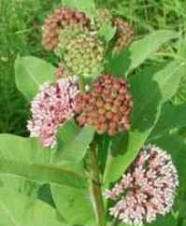Adaptations
If you read the habitat page, you know
that Asclepias syriaca can grow in many different habitats.
It has also been able to grow in new environments that have been
human created, in other words, environments that it was not native
to. This indicates that milkweed can adapt very well to many
different climates, soil types, and the presence of other organisms.
One reason milkweed is able to sustain such a wide variety of
habitats is its root system. Milkweed has both horizontal and
vertical roots, of which can reach depths of 12.5 feet into the
ground (Anderson, 1999). The horizontal
roots also produce buds underground,
which then become new stalks the following spring. The
toxin produced by milkweed comes into play
when possible predators are introduced to the scene. Since many
animals die from the toxin milkweed produces, they do not feed on
this plant. Its ability to self-fertilize
also plays a role in its success and adaptability since it does not
solely depend on insects for pollination. Milkweed also provides
protection for its seeds in pods that are tough, especially when
mature.
http://thecluelessgardeners.blogspot.com/2010/08/milkweed-roots.html
Proceed to the nutrition page, or return home.

 wikimedia
wikimedia